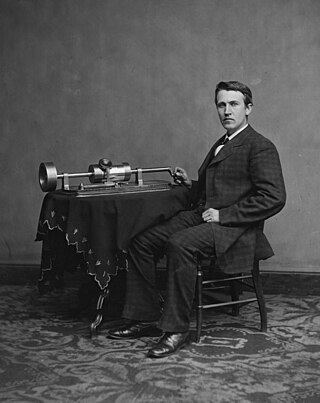
A phonograph, later called a gramophone, and since the 1940s a record player, or more recently a turntable, is a device for the mechanical and analogue reproduction of recorded sound. The sound vibration waveforms are recorded as corresponding physical deviations of a spiral groove engraved, etched, incised, or impressed into the surface of a rotating cylinder or disc, called a "record". To recreate the sound, the surface is similarly rotated while a playback stylus traces the groove and is therefore vibrated by it, very faintly reproducing the recorded sound. In early acoustic phonographs, the stylus vibrated a diaphragm which produced sound waves which were coupled to the open air through a flaring horn, or directly to the listener's ears through stethoscope-type earphones.

Phonograph cylinders are the earliest commercial medium for recording and reproducing sound. Commonly known simply as "records" in their heyday, a name which has been passed on to their successor, these hollow cylindrical objects have an audio recording engraved on the outside surface which can be reproduced when they are played on a mechanical cylinder phonograph. In the 1910s, the competing disc record system triumphed in the marketplace to become the dominant commercial audio medium.
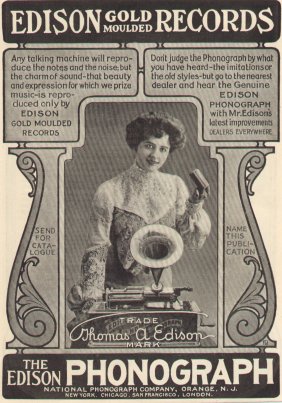
Edison Records was one of the early record labels that pioneered sound recording and reproduction, and was an important and successful company in the early recording industry.

Blue Amberol Records was the trademark name for cylinder records manufactured by Thomas A. Edison, Inc. in the US from 1912 to 1929. They replaced the 4-minute black wax Amberol cylinders introduced in 1908, which had replaced the 2-minute wax cylinders that had been the standard format since the late 1880s. Blue Amberols can play for as long as 4 minutes and 45 seconds and have a surface layer of the "indestructible" plastic celluloid, which Edison tinted a trademark blue color. Edison brand phonographs designed to play Amberol cylinders were named Amberolas.
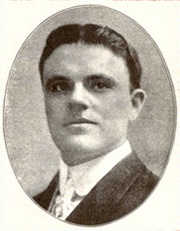
William Thomas Murray was one of the most popular singers in the United States in the early 20th century. While he received star billing in Vaudeville, he was best known for his prolific work in the recording studio, making records for almost every record label of the era. Murray was the best-selling recording artist of the first quarter of the 20th century, selling over 300 million records during the phonograph era.

The Dickson Experimental Sound Film is a film made by William Dickson in late 1894 or early 1895. It is the first known film with live-recorded sound and appears to be the first motion picture made for the Kinetophone, the proto-sound-film system developed by Dickson and Thomas Edison. The film was produced at the "Black Maria", Edison's New Jersey film studio. There is no evidence that it was ever exhibited in its original format.

George J. Gaskin was one of the most popular singers in the United States during the 1890s and an early American recording artist.
The Cylinder Audio Archive is a free digital collection maintained by the University of California, Santa Barbara Library with streaming and downloadable versions of over 10,000 phonograph cylinders manufactured between 1893 and the mid-1920s. The Archive began in November 2003 as the successor of the earlier Cylinder Preservation and Digitization Pilot Project.

Daniel William Quinn was one of the first American singers to become popular in the new medium of recorded music. Quinn was a very successful recording artist whose career spanned from 1892 to 1918. Quinn recorded many of his hits in the legendary Tin Pan Alley of New York City.
Archeophone Records is a record company and label founded in 1998 to document the early days of America's recording history. It was started by Richard Martin and Meagan Hennessey, a husband and wife who run the company in Champaign, Illinois. Archeophone restores and remasters audio from cylinders and discs of jazz, popular music, vaudeville, and spoken word recordings.

Actionable Offenses: Indecent Phonograph Recordings from the 1890s is a compilation of jokes and stories recorded to wax cylinders during the 1890s. At the time the recordings were made, they were considered indecent, and nearly all similar recordings from this era have been destroyed, often by law. The compilation was assembled by Patrick Feaster and David Giovannoni, and released on Archeophone Records, an archival reissue label, in 2007. It received two Grammy Award nominations.

Nat M. Wills was a popular American stage star, vaudeville entertainer, and recording artist at the beginning of the 20th century. He is best known for his "tramp" persona and for performing humorous or satirical musical numbers, including parodies of popular songs of the day.

Adelbert Theodor Edward Wangemann, known as Theo, was a German who emigrated to the United States. In 1888, he began working for Thomas Edison as an assistant at his laboratory in West Orange, New Jersey. In 1889, Edison sent Wangemann to keep the phonograph at the 1889 Paris Expo in good working condition. The trip was extended and Wangemann made numerous early sound recordings on wax cylinders, some of which were lost for more than 100 years. Found in 1957, but not revealed until 2012, they include the only known recording of Otto von Bismarck.

The Indestructible Record Company was an American record label that produced plastic cylinder records between 1907 and 1922.
The Manhansett Quartet or Quartette, or Manhasset Quartet, was an American vocal group. It was the first such group to make commercial recordings in its own name, between about 1891 and 1901.
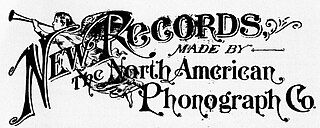
The North American Phonograph Company was an early attempt to commercialize the maturing technologies of sound recording in the late 1880s and early 1890s. Though the company was largely unsuccessful in its goals due to legal, technical and financial problems, it set the stage for the modern recording industry in the mid 1890s.

Charles Adam Asbury was an American banjo player and pioneer recording artist active from 1876 to 1897. On the stage, he played parts that emphasized his multiracial ancestry, and his recording work was largely in the minstrel tradition. His surviving recordings are the earliest examples of the stroke style of banjo.

Joseph Tunnicliffe Pope, Jr., known professionally as Murray K. Hill was an American vaudeville comic and recording artist active from the 1900s-1920s.
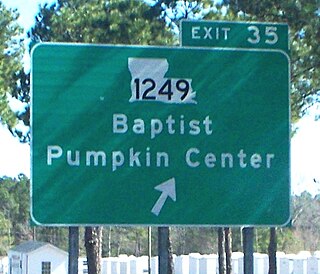
Pumpkin Center is an unincorporated community in Tangipahoa Parish, Louisiana, United States. Pumpkin Center is located on U.S. Route 190, west of Hammond.

Uncle Josh at the Moving Picture Show is a 1902 American short silent comedy film directed by Edwin S. Porter, featuring a naive spectator trying to interact with films projected onto a screen. It is an almost identical remake of a British 1901 film directed by Robert W. Paul, The Countryman and the Cinematograph. Paul's film was the first to feature a film shown within a film.



















